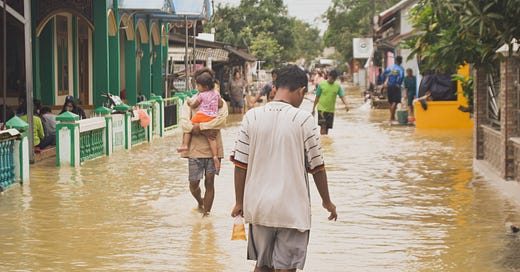The Atlas of Climate Displacement – Part I
Climate displacement has forced millions of people across the globe to leave their homes as neighbourhoods, towns and cities are rendered inhabitable and ravaged by extreme weather events and intensified seasons.
The forced migration that has occurred to date as a result of runway climate change and rising global temperatures is discriminatory. Nations already crippled by economic poverty, political instability and ongoing conflicts are often the most vulnerable to climate displacement.
The Atlas of Climate Displacement is our endeavour to fill the data gap that exists on this salient topic, charting the narrative and emotions of how displacement is truly affecting communities in climate hotspots.
In Part 1, we dissect the origins of climate displacement and climate gentrification to uncover the blind spots that are yet to be addressed by existing research. Alongside this, we evaluate the rhetoric surrounding the lexicons, tracing their evolution as the climate crisis continues to unravel and touch every area of the world. At Ripple Research, we pertinently address what traditional research techniques have failed to detect when it comes to the narrative of displacement and how it is affecting the emotions of vulnerable communities most at risk to forced migration.
An overview of climate displacement
Climate displacement refers to the forced migration of communities due to the rapid escalation of extreme weather events, be those floods, droughts or wildfires. This phenomenon can run in congruence with the direct effects of global warming such as rising sea levels and desertification.
This migration can take place within a person’s country of origin, referred to as internal displacement or can also involve cross-border migration to new countries, noted as international displacement and often rendering citizens as climate refugees.
According to a recent report by the Internal Displacement Monitoring Centre, over 30 million people across the world migrated domestically due to extreme weather events in 2020, signalling record numbers. Indeed, there appears to be a direct correlation between the record-breaking temperatures experienced and the number of internally displaced peoples recorded.
Parallel to this, the UN High Commissioner for Refugees (UNHCR) has noted from an investigation that 90% of refugees come from countries that are the most vulnerable and least ready to adapt to the impacts of climate change including nations torn apart by conflict, such as Afghanistan.
These climate hotspots including Vietnam, Cambodia and the Philippines or geographies such as India, Pakistan and Bangladesh face multiple threats related to climate displacement that go beyond conflict, to focus on socio-economic risks - in particular how it will erode the livelihoods of many who are dependent on rural agriculture as they are forced to flee.
The rise of climate gentrification
Forced internal migration has cast climate gentrification, an important dimension of climate displacement into the spotlight.
The phenomenon is depicted by the process where wealthier populations migrate to areas less exposed to the impacts of climate change, regions which were previously occupied by lower-income residents, often minority communities.
With visible societal impact, the term climate gentrification has been popularised following the publication of a 2018 Harvard University study which explored how certain neighbourhoods in Miami, Florida have become increasingly desirable and expensive due to their climate resilient properties and location on elevated land. The results demonstrated that the impacts of climate change will affect the marketability and valuation of property with varying degrees related to environmental exposure and resilience functionality.
As a consequence, this priced out lower-income communities who have previously resided in Little Haiti in Florida where the land is double the elevation of wealthier water front neighbourhoods in the city. The case of Little Haiti has become the archetype of a town influenced by climate gentrification and serves as evidence as to how the ramifications of climate change can create social injustice and widen inequalities.
Further evidence exists in California, Venice, Spain and Sweden which shows that migrants and lower income communities are likely to be displaced in the short and medium term by the construction of new green spaces and sustainable infrastructure which will have a multiplier effect and increase property values.
In addition to the surge in house prices that sit on elevated land, the alarming rise in property insurance premiums as a direct response to extreme weather events and disasters, could exacerbate housing affordability for the most vulnerable. This comes as Swiss RE report that property insurance premiums are expected to triple to $1.3 trillion by 2040.
For those with less disposable income, they may be forced to migrate to areas that are uninsurable or will be enticed by cheap property prices but come at the cost of direct exposure to wildfires or flooding.
Methodology
How are communities discussing the impact that climate change has on the locations they have been forced to leave?
Our insights on climate displacement are derived from the analysis of open-source intelligence, collected from social media networks, news websites and online blog platforms from the two-year period of November 2019 through to November 2021.
The analysis stems from related conversations that have garnered over 250,000 mentions from a significant 138,000 unique authors.
The below figure represents the mention volume by city relating to climate displacement as identified by Ripple Research data.
To discover the detailed insights from our research on climate displacement including demographic trends, sentiment analysis and emotions mapped through these conversations, continue reading Part II of The Atlas of Climate Displacement stay tuned.
Are you subscribed to Track Changes to receive all the latest insights and case studies from Ripple Research? Please send us your thoughts and feedback.


